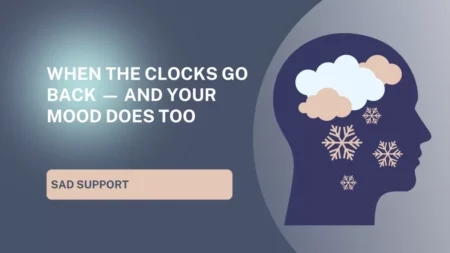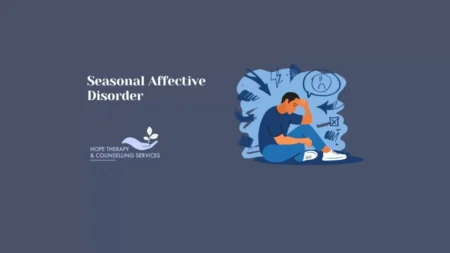
Understanding Seasonal Affective Disorder (SAD)
Feel the weight of winter? You’re not alone. Seasonal Affective Disorder (SAD) is a type of depression that occurs at the same time each year, most commonly during the fall and winter months when daylight is scarce. While everyone may experience a case of the winter blues now and then, SAD is a more profound and persistent condition that can significantly affect your daily life.
At Hopeful Minds, we’re here to help you understand and manage this seasonal challenge with the care and resources you deserve.

What Is Seasonal Affective Disorder?
SAD is a form of depression linked to the change in seasons, typically starting in the fall and continuing into the winter months. The reduced sunlight during this period affects your body’s internal clock (circadian rhythm), leading to changes in mood and energy levels.
For some, the effects of SAD can feel overwhelming, impacting work, relationships, and overall well-being. It’s not just “feeling a bit down”—it’s a real condition that requires attention and support.
Symptoms of SAD
The symptoms of Seasonal Affective Disorder can vary from person to person but often include:
- Persistent feelings of sadness or low mood.
- Loss of interest in activities you once enjoyed.
- Fatigue or lack of energy, even with adequate sleep.
- Difficulty concentrating or making decisions.
- Increased cravings for carbohydrates and weight gain.
- Sleeping more than usual (hypersomnia).
- Feelings of hopelessness, worthlessness, or guilt.
If you notice these symptoms returning year after year with the changing seasons, you might be experiencing SAD.

What Causes SAD?
The exact causes of SAD aren’t fully understood, but factors include:
- Reduced Sunlight: Shorter days disrupt your body’s production of serotonin, a chemical that affects mood.
- Melatonin Levels: Changes in light can impact melatonin, which influences your sleep-wake cycle and mood.
- Circadian Rhythm Disruption: Seasonal changes can throw off your internal body clock, leading to feelings of sluggishness or depression.
How We Can Help
At Hopeful Minds, we offer tailored resources to help you manage SAD and reclaim your sense of well-being. Our approach combines evidence-based strategies with compassionate care to support you through the darker months.
Treatment Options
- Light Therapy: Exposure to a special lightbox can help regulate your body’s natural rhythms.
- Counseling & Therapy: Talking with a therapist can help address negative thought patterns and develop coping strategies.
- Mindfulness & Relaxation Techniques: Practices such as guided meditation and breathing exercises can improve your mood and resilience.
- Lifestyle Adjustments: Simple changes like increasing outdoor time, maintaining a regular schedule, and eating a balanced diet can make a big difference.
Additional Support
- Mindfulness Downloads: Access guided mindfulness exercises designed to help you manage stress and improve your mood.
- Community Stories: Read how others have successfully navigated SAD to find inspiration and hope.
- Stay Connected: Sign up for our newsletter to receive tips, insights, and updates directly to your inbox.
- Understanding seasonal mood changes — and how counselling can help you find your balance againWhen the clocks go back, many people feel it — that subtle emotional fog that rolls in with the darker evenings. You might find yourself more tired, more irritable, or simply less motivated. The mornings feel heavier, and by late afternoon it’s already dark outside, signalling to your body that it’s time to wind down … Read more
- When the Clocks Go Back — and Your Mood Does Too
 Every year, it sneaks up on us. One weekend, the evenings are golden and drawn out; the next, darkness has arrived before most of us have even finished work. For many, the clocks going back brings a welcome excuse to curl up earlier, light a candle, and rest. For others, it feels like something more … Read more
Every year, it sneaks up on us. One weekend, the evenings are golden and drawn out; the next, darkness has arrived before most of us have even finished work. For many, the clocks going back brings a welcome excuse to curl up earlier, light a candle, and rest. For others, it feels like something more … Read more - Feeling Down This Winter?
 Seasonal Affective Disorder The colder months bring shorter days, longer nights, and a distinct chill in the air. For many, this is a time to revel in cosy jumpers, festive gatherings, and the beauty of frost-covered mornings. However, for others, the changing seasons come with a heavy emotional toll. If you’ve noticed a persistent dip … Read more
Seasonal Affective Disorder The colder months bring shorter days, longer nights, and a distinct chill in the air. For many, this is a time to revel in cosy jumpers, festive gatherings, and the beauty of frost-covered mornings. However, for others, the changing seasons come with a heavy emotional toll. If you’ve noticed a persistent dip … Read more
